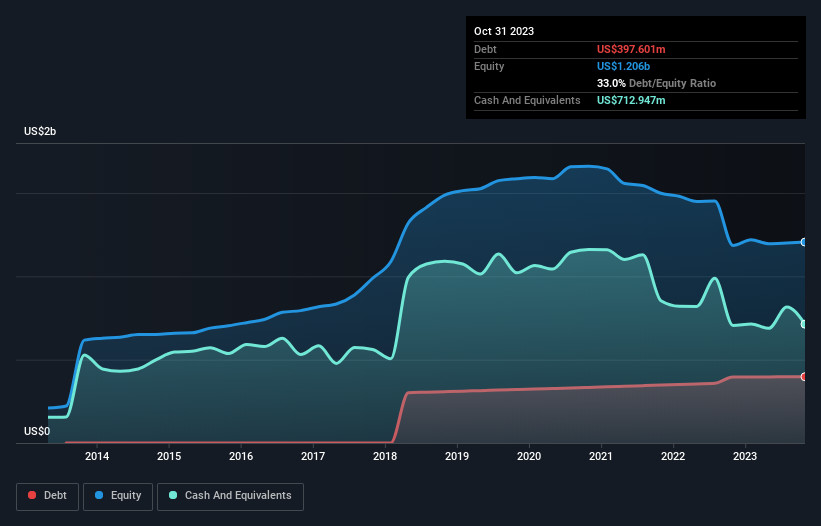
Howard Marks put it nicely when he said that, rather than worrying about share price volatility, 'The possibility of permanent loss is the risk I worry about... and every practical investor I know worries about.' So it seems the smart money knows that debt - which is usually involved in bankruptcies - is a very important factor, when you assess how risky a company is. As with many other companies Guidewire Software, Inc. (NYSE:GWRE) makes use of debt. But should shareholders be worried about its use of debt?
Why Does Debt Bring Risk?
Debt is a tool to help businesses grow, but if a business is incapable of paying off its lenders, then it exists at their mercy. In the worst case scenario, a company can go bankrupt if it cannot pay its creditors. However, a more common (but still painful) scenario is that it has to raise new equity capital at a low price, thus permanently diluting shareholders. Of course, the upside of debt is that it often represents cheap capital, especially when it replaces dilution in a company with the ability to reinvest at high rates of return. When we examine debt levels, we first consider both cash and debt levels, together.
View our latest analysis for Guidewire Software
What Is Guidewire Software's Net Debt?
The chart below, which you can click on for greater detail, shows that Guidewire Software had US$397.6m in debt in October 2023; about the same as the year before. But on the other hand it also has US$712.9m in cash, leading to a US$315.3m net cash position.

A Look At Guidewire Software's Liabilities
Zooming in on the latest balance sheet data, we can see that Guidewire Software had liabilities of US$262.4m due within 12 months and liabilities of US$451.6m due beyond that. On the other hand, it had cash of US$712.9m and US$202.3m worth of receivables due within a year. So it actually has US$201.3m more liquid assets than total liabilities.
This surplus suggests that Guidewire Software has a conservative balance sheet, and could probably eliminate its debt without much difficulty. Simply put, the fact that Guidewire Software has more cash than debt is arguably a good indication that it can manage its debt safely. There's no doubt that we learn most about debt from the balance sheet. But ultimately the future profitability of the business will decide if Guidewire Software can strengthen its balance sheet over time. So if you want to see what the professionals think, you might find this free report on analyst profit forecasts to be interesting.
In the last year Guidewire Software wasn't profitable at an EBIT level, but managed to grow its revenue by 9.0%, to US$917m. We usually like to see faster growth from unprofitable companies, but each to their own.
So How Risky Is Guidewire Software?
While Guidewire Software lost money on an earnings before interest and tax (EBIT) level, it actually generated positive free cash flow US$36m. So although it is loss-making, it doesn't seem to have too much near-term balance sheet risk, keeping in mind the net cash. With mediocre revenue growth in the last year, we're don't find the investment opportunity particularly compelling. When analysing debt levels, the balance sheet is the obvious place to start. But ultimately, every company can contain risks that exist outside of the balance sheet. For example - Guidewire Software has 1 warning sign we think you should be aware of.
If, after all that, you're more interested in a fast growing company with a rock-solid balance sheet, then check out our list of net cash growth stocks without delay.
New: Manage All Your Stock Portfolios in One Place
We've created the ultimate portfolio companion for stock investors, and it's free.
• Connect an unlimited number of Portfolios and see your total in one currency
• Be alerted to new Warning Signs or Risks via email or mobile
• Track the Fair Value of your stocks
Have feedback on this article? Concerned about the content? Get in touch with us directly. Alternatively, email editorial-team (at) simplywallst.com.
This article by Simply Wall St is general in nature. We provide commentary based on historical data and analyst forecasts only using an unbiased methodology and our articles are not intended to be financial advice. It does not constitute a recommendation to buy or sell any stock, and does not take account of your objectives, or your financial situation. We aim to bring you long-term focused analysis driven by fundamental data. Note that our analysis may not factor in the latest price-sensitive company announcements or qualitative material. Simply Wall St has no position in any stocks mentioned.
About NYSE:GWRE
Guidewire Software
Provides a platform for property and casualty (P&C) insurers worldwide.
Excellent balance sheet with reasonable growth potential.


